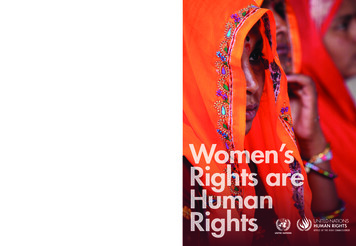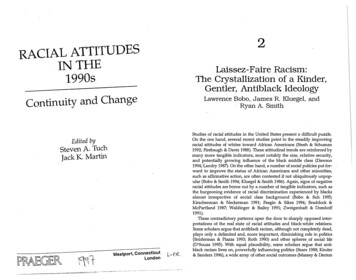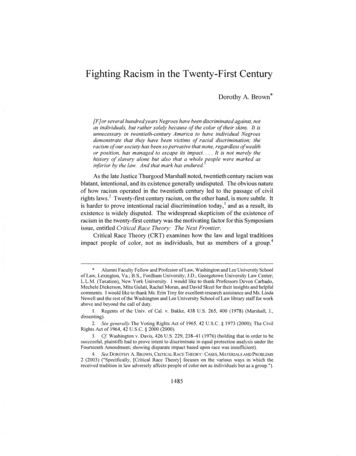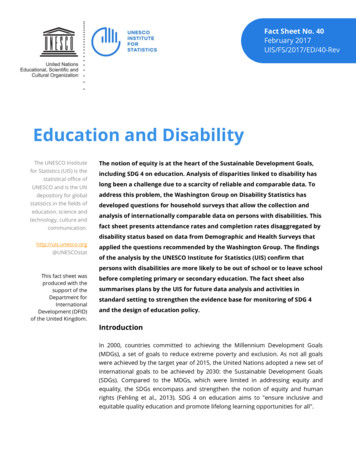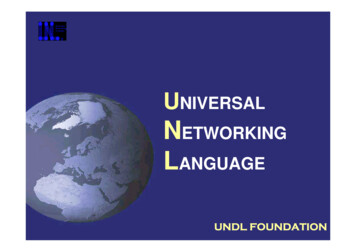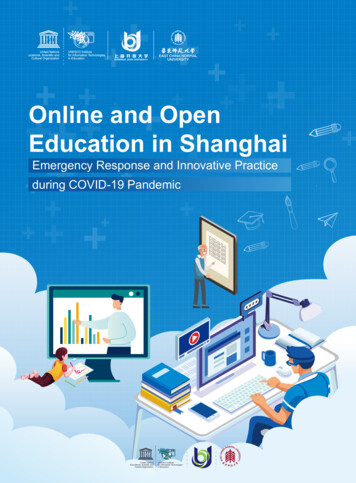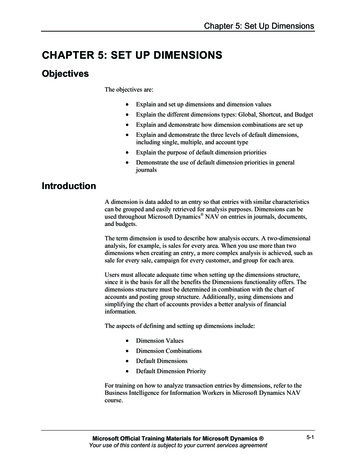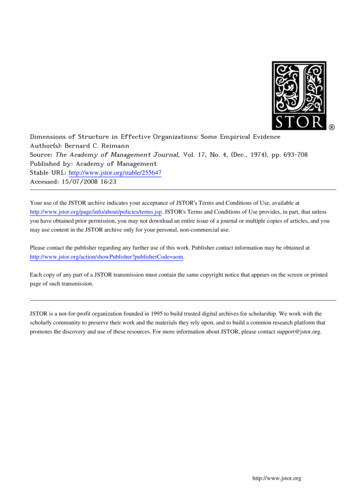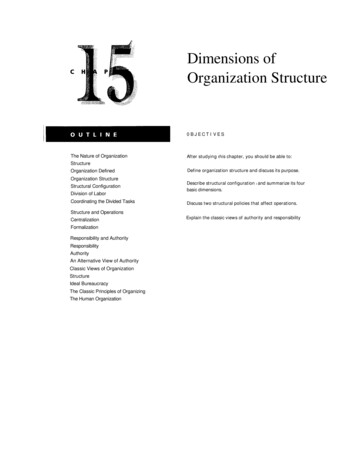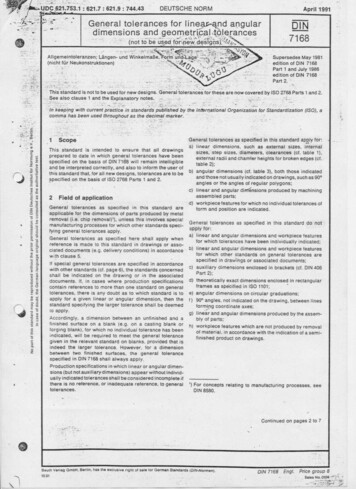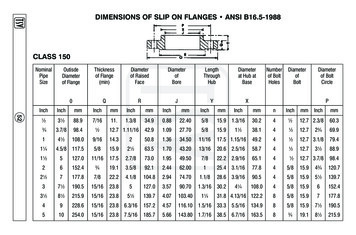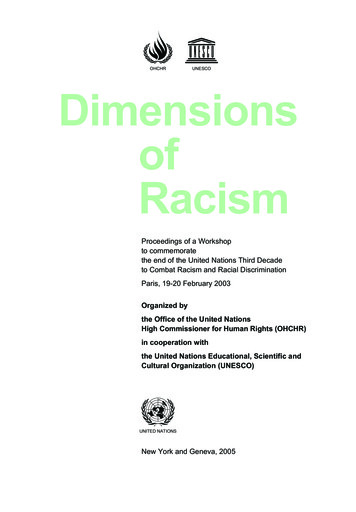
Transcription
OHCHRUNESCODimensionsofRacismProceedings of a Workshopto commemoratethe end of the United Nations Third Decadeto Combat Racism and Racial DiscriminationParis, 19-20 February 2003Organized bythe Office of the United NationsHigh Commissioner for Human Rights (OHCHR)in cooperation withthe United Nations Educational, Scientific andCultural Organization (UNESCO)UNITED NATIONSNew York and Geneva, 2005
NOTEThe papers published in this volume were presented at a workshop entitled“ Dimensions of racism ”, organized by the Office of the United Nations HighCommissioner for Human Rights (OHCHR), in cooperation with the United NationsEducational, Scientific and Cultural Organization (UNESCO), on 19-20 February 2003.The choice of the material contained in this book and the opinions expressed therein donot necessarily represent the views of UNESCO or of OHCHR and do not commit them.The designations employed and the presentation of material throughout do not implythe expression of any opinion whatsoever on the part of UNESCO or OHCHR concerning the legal status of any country, territory, city or area or of its authorities, or concerning the delimitation of its frontiers or boundaries.Material contained in this publication may be freely quoted or reprinted, provided creditis given and a copy of the publication containing the reprinted material is sent toOHCHR.Correspondence regarding this publication should be addressed to :Research and Right to Development Branch, Anti-Discrimination UnitOffice of the United Nations High Commissioner for Human RightsPalais des NationsAvenue de la Paix 8-141211 Geneva 10SwitzerlandCREDITThe drawing on the cover page was prepared by Yeison Caceres from Colombia in thecontext of the Young People Drawing for Human Rights competition organized byOHCHR Field Presences in 2003/2004.HR/PUB/05/4II
Editorial NoteThe United Nations Third Decade to Combat Racism and Racial Discrimination endedin 2003. One of the Decade’s educational activities was a workshop that brought together education and training experts, academics, United Nations human rights expertsand individuals from non-governmental organizations (NGOs) working on racism andrelated issues. The purpose of the workshop was to develop educational materials foruse by teachers and students on eliminating racial prejudice and fostering tolerance.The workshop, organized by the Office of the High Commissioner for Human Rights(OHCHR) in cooperation with the United Nations Educational, Scientific and CulturalOrganization (UNESCO), took place in Paris on 19-20 February 2003. The backgroundpapers presented at the workshop analysed racism and racial discrimination in specificcontexts, including in education, the workplace, health, migration, contemporary formsof slavery, the media, the criminal justice system, and the experience of doublediscrimination based on gender and race.Those papers form the basis of the chapters in this book. The aim of the publication isto provide a better understanding, on a cross-cultural basis, of racism, racial discrimination and xenophobia. It examines how these phenomena manifest themselves and areexperienced by victims. It explains how racism is currently combated and how it can beprevented. The intention is to generate interest and encourage students in particular todevelop ideas on how to fight racism, and to become involved in that fight.Special acknowledgement is due to Mr. Kevin Boyle of the Human Rights Centre of theUniversity of Essex in the United Kingdom, who had the task of editing this manual.Finally, thanks are due to the staff of the UNESCO Struggle against Discrimination andRacism Section and the staff of the OHCHR Anti-Discrimination Unit who were closelyinvolved in the early stages of the project.III
CONTENTSEditorial Note .IIIIntroductionKevin Boyle .1Eliminating racism in a changing world:arguments for a new strategyDoudou Diène .132The international legal response to racismNozipho January-Bardill .213Racism and educationKatarina Tomaševski .394Racism and employmentJulio Faundez .535Racism and healthCristina Torres Parodi .676Racism and HIV / AIDSShalini Bharat .837Racism and contemporary slaveryKevin Bales and Jessica Reitz .998Racism and migrationILO et al. . 1119Researching discrimination against immigrantsAugust Gächter . 1351and the administration of justice10 RacismLeila Zerrougui .153the media and the Internet11 Racism,Bent Sørensen .165and gender12 RacismSapana Pradhan-Malla .179About the authors . 193Websites . 197V
IntroductionIntroductionKevin Boyle“ All human beings are born free and equal in dignity and rights ”(Universal Declaration of Human Rights, 1948)All of us have difficulty with the idea that although we are all different we all should betreated the same. It seems ‘natural’ to ascribe negative meanings to differences, toassociate difference with the supposedly inferior or superior or the dangerous. It is not,however, natural. It is something we learn and is therefore something we can unlearn.This book is about the meanings that we give to differences between us, on account ofrace or ethnicity or nationality, and the negative effects those meanings have on thequality of life of millions of people in the world. It is also about the continuing struggle, ofwhich we as moral beings should all be a part, to understand, and ultimately eliminatefrom our world, racism, racial discrimination and xenophobia.1 This book is intended asa resource in that struggle. It is aimed at college and university-level students and theirteachers.The fight against racism begins with being informed. In the different chapters of thebook experts explain how racism manifests itself, what its effects are and how it can becountered. The authors bring out how racism, racial discrimination and xenophobiahave impacted on all our lives, but especially on those who are its victims. Racism is tobe found in all parts of the world. It is present in the workplace, in education, in healthcare and in the courts. It is to be found in the media and the Internet. It is imbued in howmajorities see and treat ethnic minorities, immigrants and asylum-seekers. It is oftenpresent in the stereotypes minority groups hold of majorities as well. It can representadditional discrimination and suffering for women or those living with HIV/AIDS. Theseare among the dimensions of racism examined in this book.This introduction will provide some flavour of the analyses and ideas presented in thechapters that follow. It will also highlight what the authors believe needs to be done ifwe are to defeat discrimination and intolerance.The Durban World ConferenceThe World Conference against Racism, Racial Discrimination, Xenophobia and RelatedIntolerance was an important event in the history of international efforts to addressracism. It was convened in 2001 in Durban, South Africa, by the United Nations and is,therefore, known as the Durban Conference. South Africa was an appropriate settingfor the Conference since a new non-racial democracy had replaced decades of institutionalized racism under apartheid. A world conference, as the name implies, is agathering that can claim to reflect world opinion and bring together Governments, inter-1
Dimensions of Racismgovernmental and non-governmental organizations or civil society groups from everyregion. The goals of the Conference were to agree upon a global repudiation of theevils of contemporary forms of racism and also to define a comprehensive programmeof action to eradicate it.The Durban Conference achieved these difficult goals over nine days of intense negotiation. The Declaration and Programme of Action adopted at the Conference by consensus provides the basis for future international cooperation against all forms ofracism and racial discrimination. These documents call for continued dialogue andresearch, as well as offering detailed proposals for national-level policy and action. TheDeclaration and Programme of Action feature strongly in this book. Excerpts are usedto introduce each chapter. The Durban texts, which are easy to access, are therefore auseful, even an indispensable, companion to consult while using this book.2Racism is a global reality. It may be comforting to think of it as confined to the West andas reflecting colonialism and the slave trade. It does include that sorry history as wasrecognized in important language in the Durban Conference documents. But forms ofracism with equally sorry histories are to be found also in other regions of the world, infact in all regions. Before the World Conference in Durban, four preparatory conferenceswere held in the different regions of the world to ensure maximum consultation and tobring out regional problems and approaches.3 Without exception, these meetings confirmed that racism, racial discrimination and xenophobia are global phenomena. Eachregional context is different of course. The victims differ in language and culture. But theexperience of exclusion, subordination, violence and discrimination is remarkably similar.So we should start by understanding racism as a worldwide phenomenon that requiresa worldwide response. All societies, and all of us in those societies, must addressracism in the forms that it manifests itself in our lives and cultures. That spirit is reflectedin the diversity of people who have contributed to this book. Glance at the authors’ biographies at the end of the volume. They are from different parts of the world and theywrite from within different intellectual disciplines. But, as they emphasize, they aredealing with a common concern – the denial of equality to fellow human beingsbecause of their race or ethnicity or nationality.The World Conference brought out the grip of history. Every one of us, whether we areconscious of it or not, are living out our lives in societies shaped by history. In all societies structures of inequality, including economic inequalities, have been laid down in thepast. In a number of cases these structures have been based on or influenced by racistassumptions that, transmitted over time have continuing effects today. The challengefor all of us is not to be passive in accepting the hand history has played, but to work forpositive change that can leave behind what has been negative about the past. A universal human rights era in which we now live gives us the necessary values and means towork to end such inequalities and the prejudices and attitudes that sustain them.2
IntroductionRights, dignity and equalityOne of the great successes of the past century has been the popularity of the idea ofuniversal human rights. But the full meaning of human rights is often not fully understood, namely equal human rights : not just rights for me and people ‘ like me ’, but foreach and every one of us, whether you are like me or not. The real message of theUniversal Declaration of Human Rights is that everyone is entitled to the same humanrights and to equal human dignity. No one can be denied their human rights becausethey are different from others, whether by sex, race or ethnicity, work or descent, caste,culture, religion, skin colour or other grounds. The struggle to ensure equality of treatment for everyone is thus at the centre of all efforts to promote the universal protectionof human rights.Racism and anti-racism is first a battle of ideas. This truth is conveyed well in DoudouDiène’s chapter. He notes that the new and shared context of globalization is not initself transformative – the speed of communications and the interconnectedness of theworld will not inevitably lead to the demise of racism. To the contrary, the impact ofglobalization can, he believes, give a boost to racism : “ the ‘ global village ’ spanningthe world has produced more villages, and more insularity, than it has global consciousness. ” The impact of the horrific events of 11 September 2001 in the United States, interms of increasing levels of hostility to immigrants and asylum-seekers in many countries, is also noted. The writer argues for a new intellectual strategy that gets at thedeep cultural roots of racism and discrimination. The chapter sets out some key elements of that strategy as well as its goal. The goal is to achieve mutual accommodationand understanding and that can best be done through recognition of the mutual influences that exist and have existed between cultures, civilizations and spiritual traditions.This contribution offers an exciting direction for further research as well as a frameworkof thought to help address the cultural antagonisms that are very evident in manysocieties. In concrete terms all societies that receive immigrants need to explore whatthe new and old populations have in common as an antidote to the assumption thatthey are wholly different. All societies are becoming increasingly multicultural or pluralist and there is an equal obligation on the newcomers and on those who have beenthere for generations to learn about each other. Such a learning process will reveal thepotential for mutual appreciation of each other’s cultures and customs as well as fostercompromise and tolerance. Such a process hopefully will bring out that their respectivecultures are less remote from each other than stereotypes project and will also providethe basis of trust for managing inevitable problems. That process, it may be noted, isbest supported by a framework of laws that enshrine human rights and equality principles within which cultural affinities can be recognized and differences negotiated.Learning about others and the overcoming of mutual ignorance are ideals of education.The role of education in ending racism is addressed by Katarina Tomaševski, who forsix years was a United Nations expert or ‘ special rapporteur ’ on the right to education.3
Dimensions of RacismWhat is distinctive about her ideas is her conviction that only the integration of humanrights learning and teaching into education can ensure that racial prejudice and intolerance are successfully combated in children when they are in school and out of school.She notes that the implementation of the right to education for all is a progressiveachievement. She sketches the stages of that progress from the gradual inclusion ofthose previously excluded from education for racist motives (as in the school segregation of African children in colonial times, the Roma in Europe, the untouchables in Indiaor black children in the United States of America), to the stage of integration. She argues,however, that there is a further stage to be achieved in which the cultural diversity of childrenis recognized. The previous requirement that children adapt to the education availableshould give way to one in which education is adapted to the best interests of each child.The contributions from Mr. Diène and Professor Tomaševski are asking us to considerhow best to combine pluralism with the necessary common values that enshrine equality and dignity. It is that combination which will provide our societies with the very bestdefence against the perpetuation of racial prejudice and discrimination.The role of lawThe function of law, both national and international, is to translate the principle of nondiscrimination into binding norms or rules on how we should behave. Such rules aredesigned first to offer legally binding protections and also redress for those victims ofdiscrimination. Second, these rules impose obligations on Governments and on all of usnot to act in a discriminatory manner. Over the past half-century or so extensive effortsat international level have been made to find effective uses of law to end racism andracial discrimination. Countries have negotiated and ratified many international legalinstruments. Nozipho January-Bardill surveys these instruments. She notes that theUnited Nations has expended more effort to tackle racial discrimination than on anyother human rights issue. The centrepiece of the international community’s driveagainst racial discrimination is the International Convention on the Elimination of AllForms of Racial Discrimination. Its requirements have been accepted by over threequarters of the States in the world. The Convention’s definition of racial discriminationprovides a useful perspective on the subject.“ In this Convention the term ‘ racial discrimination ’ shall mean any distinction,exclusion, restriction or preference based on race, colour, descent, or national orethnic origin which has the purpose or effect of nullifying or impairing the recognition, enjoyment or exercise, on an equal footing, of human rights and fundamentalfreedoms in the political, economic, social, cultural or any other field of public life. ”With that definition as a guide, States are required by the Convention to pass their ownlaws and to enforce them so as to prevent and to punish racial discrimination in allaspects of public life. Governments must ensure that those who experience racial discrimination have effective access to courts or other bodies to complain of such treat-4
Introductionment and have an adequate remedy. States must also condemn and seek to end thepropagation of discredited theories or ideas claiming the superiority and inferiority ofracial or ethnic groups as well as speech that promotes racial hatred. There are alsoduties on States to promote education for tolerance and mutual understanding. TheConvention does one other vital thing. It incorporates a monitoring system wherebyStates are expected to give regular progress reports to an independent internationalcommittee (of which Ms. January-Bardill is a member). Her contribution provides abalanced assessment of what the Convention and its monitoring committee haveachieved to date, along with an analysis of other international initiatives andmechanisms working for the elimination of racial discrimination.A related topic is the challenge presented where racial prejudice infects the law itselfand the administration of justice within society. Leila Zerrougui examines the problem ofracial and ethnic discrimination in the criminal justice system. She finds that it is adimension of racism that has been uncovered in many countries and that it exists inothers where it has yet to be addressed. The evidence is to be found in the behaviourof the police, the courts and the prisons. Amnesty International, for example, hasdescribed as blatant ethnic discrimination in the entire criminal justice system ofBurundi. Research from the United States of Amercia, shows that race and ethnicitymatters when it comes to sentencing, including to the death penalty.The author concludes a fairly depressing picture with the statement that “ the elimination of manifestations of racism, xenophobia and related intolerance in the administration of justice is a long and costly process that requires political will and the mobilizationof resources as well as education, research and advocacy. Above all, in order to carryconviction, we need research that fathoms the workings of those mechanisms thatperpetuate discrimination. ”Her plea for more research is echoed in other contributions. Not enough is yet knownabout the nature and extent of racism and racial discrimination or on how best to combat it.Racism, poverty, employment and healthIt is often said that legal prohibitions on racist behaviour cannot eliminate the attitudesthat underlie such behaviour. As Julio Faundez points out in his chapter on racial discrimination in employment, however, law is a necessary starting point in tackling otherfactors that perpetuate such discrimination. Against a background of discussion of theessential human right to have access to work, the author provides a clear account ofhow discrimination in employment operates and gives examples of how it can be countered in the labour market. Racial discrimination can exclude people from work but it isalso experienced at work in the form of racial harassment. Both need to be tackled andthe policies needed require employer and trade union cooperation and commitment tointernational labour standards.5
Dimensions of RacismThis chapter also addresses the particular challenges created for the elimination of discrimination where there is large-scale unemployment and poverty. In many developingcountries victims of racial discrimination live in conditions of extreme poverty withouthope of obtaining qualifications and, therefore, no opportunity of entering the formallabour market. Professor Faundez cites the case of indigenous peoples who are oftenremote from where work might be available and he also highlights the case of poorwomen without skills who are exploited in low-paid jobs, including as domestic servants,or who eke out a living in the informal sector. Anti-discrimination policies therefore needto take into account conditions of extreme poverty and unemployment and the authorsuggests how that might be done.The links between extreme poverty and racial discrimination is a recurrent theme inseveral of the chapters of this book. So also are the links between racism, gender,poverty and health. Dr. Torres Parodi explores the question of health and racism withdata largely drawn from her own region, the Americas. Her chapter reviews theresearch evidence that brings out the dismal correlation that exists between health status and ethnic or immigrant status in different countries. Minorities fare worst on suchindicators as infant mortality or life expectancy and illness. The correlation betweenpoverty and health status, as well as access to health care, is also clear, but the poorwho are black, indigenous or socially marginalized suffer even more and being femaleadds a further layer of disadvantage.HIV/AIDSA similar human reality underlies one of the most devastating health emergencies ofour time, the pandemic known as HIV/AIDS. HIV is the acronym of the humanimmunodeficiency virus, which can lead to the disease of AIDS, or acquired immunodeficiency syndrome. As Shalini Bharat argues in her chapter, the early focus on gaymen and other ‘risk groups’ obscured the extent to which factors of race, class and gender properly define HIV/AIDS as a social as well as a medical problem. Her examinationof the powerful concept of stigma linked to racial stereotyping brings out that many people living with HIV/AIDS are also victims of racism. She demonstrates from empiricaland other information how gender is an additional factor in the discrimination faced bywomen with HIV/AIDS. Awareness of the human dimension of the tragedy of AIDS hasincreased considerably with the vigorous promotion of a human rights perspective. Thatperspective also offers a good basis for community action to combat prejudice and discrimination towards HIV/AIDS sufferers. UNESCO and UNAIDS have produced anexcellent educational pack for youth action on human rights and HIV/AIDS.4 In it ayoung medical student, campaigner in Indonesia, states :“ The basis of discrimination against people living with HIV/AIDS is fear and thisfear comes mostly from wrong or distorted information so, our first step had tobe to correct misunderstandings about how HIV is transmitted ”6
IntroductionThe HIV/AIDS Human Rights Guidelines, prepared by OHCHR and UNAIDS andthe basis of the youth educational pack, are suggested for follow-up reading toMs. Bharat’s chapter.MigrantsA distinctive feature of the Durban Conference documents is their ‘ victim approach ’,meaning that anti-racism policies need to understand more precisely who are the targets of racism and what are their specific needs for protection. A category of victim thatfeatures prominently in the recommendations from Durban is that of migrants. Twochapters in the present book address the discrimination faced by millions of peoplewho live and work in countries other than that of their birthplace. We are told in the firstsentence of chapter 8 that :“ [O]ne in every 50 human beings is a migrant worker, a refugee or asylumseeker, or an immigrant living in a ‘foreign’ country. Current estimates by the UnitedNations and the International Organization for Migration (IOM) are that some175 million people live temporarily or permanently outside their countries of origin(2.5 per cent of the world’s population). ”These are arresting figures, as is the evidence of the hardships, xenophobia, racial discrimination and violence experienced by these different categories of migrants. Thechallenge of immigration facing society – and in a globalizing world it is the experienceof most countries – is how States can adapt to multicultural and multi-ethnic societies.Part of the answer lies in the proposals for intercultural exchange of Doudou Diène(chapter 1), but a further requirement is to ensure effective laws prohibiting discrimination and exploitation of migrant workers and their families. Many migrants are unskilledmanual workers who fill the ‘ three-D ’ jobs, as they are described in Asia – dirty, difficultand dangerous. The human rights perspective on migration is addressed in chapter 8not only in respect of the migrant who has arrived in a foreign country, but also inrespect of the experience of migration itself. A huge concern is the trafficking of humanbeings, especially women and children ; another is the plight of illegal migrants who arevulnerable to exploitation by unscrupulous employers; and still another is refugees andasylum-seekers.Research on the negative reactions of the settled population to newcomers oftenexpressed in racism and hostility is examined by August Gächter, an expert in socialresearch methods. He looks at evidence from public opinion research (Euro-barometerdata) on attitudes of European Union citizens to ethnic minorities and immigrants. Healso introduces other studies aimed at uncovering evidence of formal and informal discrimination. Formal discrimination is that sanctioned by law, particularly in respect ofnon-citizens, and informal discrimination is that which is unlawful but is neverthelesspractised in different ways. Part of what he teaches us is how to interpret the results ofanti-discrimination research and to be aware of the scientific limitations inevitably asso-7
Dimensions of Racismciated with it. Thus, he points to the difficulties of comparing statistics from differentcountries where, despite efforts to develop common statistical protocols, many data ofinterest are wholly incomparable. He is also direct in declaring how much we still do notknow about how discrimination operates in practice and, joining others, makes a pleafor further research, including into the effectiveness of anti-racism training.The media and racismMigration is a huge and complex subject generating political controversy that isreflected every day in the European media. Bent Sørensen examines the negative andalso the positive aspects of European media treatment of immigrants, asylum-seekersand minorities. He sets out the problem:“ Media policy and coverage often contribute to a racist vision of social realityby suppressing positive information about groups targeted by racists. Generally,the media in the news about ethnic, cultural, religious minorities and migrants inEurope focus on negativity, problems and crime. ”While documenting the negative media treatment, the author also identifies media initiatives to understand minorities, convey their points of view and enable their participationin the media. He finds that the responsibility of the media in reinforcing the racist opinionsand hostile attitudes that can produce an atmosphere tolerant of violence towards vulnerable groups is not sufficiently acknowledged by media owners or journalists.This chapter examines also the vexed issue of racism and anti-Semitism on theInternet. There have been efforts at legal control of the dissemination of hate on theInternet and racist content and pornography are unlawful Internet content in manycountries. Such regulatory efforts have, however, had limited effect and there is thebroader issue of principle, the legitimacy of censorship. Could anything more be donethrough regulation ? Does the Internet require a regulatory regime separate from thatfor the written press or radio and television ? Or is it a matter of accepting that the racistcontent, like other undesirable content such as pornography, should be seen in theperspective of the extraordinary and much greater volume of positive content that canbe accessed with this wonderful new communications t
additional discrimination and suffering for women or those living with HIV/AIDS. These are among the dimensions of racism examined in this book. This introduction will provide some flavour of the analyses and ideas presented in the chapters that follow. It will al
